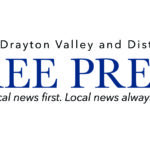When winter weather strikes people rely on their tax dollars to go to work clearing those roads and making them safe.
Adam Saltesz, the assistant director of Public Works for Brazeau County, says when a big snowfall comes, crews are on the roads at 6 a.m. working on clearing them. They work until 6 p.m. each night and go for seven days a week.
“They’re out on the roads before most of us even get out of bed in the morning, which is pretty impressive,” says Saltesz.

Valley Gallery and Framing
Share on facebook Facebook Share on email Email Share on linkedin LinkedIn Share on whatsapp

St. Anthony Catholic Church
St. Anthony’s Parish Drayton Valley. Weekend mass Saturday and Sunday

Life Church Drayton Valley
We know that exploring a new church can be an overwhelming experience. To help you

Drayton Valley Community Church
DV Community Church. Located at Affinity Funeral Services, officiated by Dwayne Henley.
Dr. Chris Birchall Dentistry
Dr. Birchall Dentistry in Drayton Valley, Alberta. A dentist in Drayton Valley, Alberta.
He says the recent snowfalls have been particularly difficult for the County to work on. “The freezing rain event we recently experienced caused our roadways to become quite icy, and when compounded with the extended periods of extreme cold, winter maintenance activities became much more difficult. These low temperatures we have seen recently are not only hard on the equipment, they also decrease the effectiveness of the salt used for roadway de-icing purposes. In the de-icing world, the practical working temperature of salt is generally considered to be above -15°C. Below -15°C, the ice melting speed of salt becomes impractically slow and ineffective.”
He says the first priority is the paved roadways, which they try to keep as close to bare as possible.
“We try to get them cleared within eight hours of the snow event,” he says. They try to get to the paved roadways quickly to prevent snow and ice from getting packed down by people travelling to work.
An all Canadian team that included a local resident was able to win the rodeo for the first time in the history of the World Famous Miles City Bucking Horse Cowboy Mardi Gras.
Wilfred Titanich was one of a team of three that attended the three-day event in Miles City, Montana from May 15-18. Titanich along with two brothers, Cory and Cody Loken, were the first all Canadian team to win at Bucking Horse since the first Miles City Bucking Horse Sale started in 1951.
Each member of the team came home with around $7,500 US, says Titanich.
“We got Championship Buckles and we got Championship Holders, too,” he says.
The team participated in the Wild Horse Racing event, which involves at least three people and an untouched horse. The horse starts out in the bucking chute and two members of the team follow the horse out, holding onto a long lead. One person is the mugger, and their job is to control the horse’s head by covering its eyes with his arm, which calms it and prevents it from rearing and hurting someone. The shanker holds onto the rope so it doesn’t run away. The rider saddles it, mounts, and holds on tight as they race to the finish line on a wild horse.
“Wild Horse Racing is one of the oldest events in rodeo,” says Titanich.
Though the event is called Wild Horse Racing, the horses used in the event are owned, but untouched.
Throughout the year, Titanich works the Canadian Wild Horse Racing Association Circuit, spending most of his time in Alberta, but also attending some events in B.C. and Saskatchewan, where he competes in both amateur and pro rodeos.
“Honestly, it’s really addicting,” says Titanich. “It looks really crazy, and it is pretty wild, but it’s super addicting. It’s an adrenaline rush in sport.”
He says he would encourage people who like competitive events to try Wild Horse Racing.
The Loken brothers have both been in the sport for about 15 years, says Titanich. Both of them were about 14-years-old when they first started out. Titanich has been in the sport for three or four years.
Normally, the Lokens race with their dad, Jason, and Titanich has his own team. But the three of them thought it would be fun to head down to Miles City for some fun.
The Bucking Horse Sale was a stand-alone event, says Titanich. His team is getting ready for the circuit this summer.
“We can rodeo every weekend from now to the end of October,” he says.
Anyone looking for information about which wild horse racing rodeos are coming up can visit www.wildhorseracing.ca. Titanich says he will be in Brooks at the Lea Park Rodeo this weekend and in Killam for the Killam Rodeo that will be held outdoors in Sedgewick this year.
From Oklahoma to Keystone: Uncovering Hidden Histories at the Breton Library
An author who has written a non-fiction book that ties the Breton area to a mysterious child in Oklahoma will be visiting the Breton Library on June 7.
Russell Cobb, author of Ghosts of Crook County: An Oil Fortune, A Phantom Child, and the Fight for Indigenous Land is a Professor of Modern Languages and Cultural Studies at the University of Alberta. He was invited to the library by the Breton Library Board and the Breton Museum.
Allan Goddard, the manager of the Breton Museum, says he met Cobb when the author was working on the manuscript for the novel.
“He came out to the museum because there is a connection to the Hooks family,” he says.
Goddard says while the book does have some history about the Keystone area, and some relatives that may still live in the area, it is mainly about what indigenous families had to deal with in the early 1900s in Oklahoma.
Claire Sather, the Chair of the Board of Trustees for the Breton Library, says she read the book after finding it on Goodreads, a social media site dedicated to book ratings and reviews.
She says when she got to the end and saw a familiar name, Brandy Fredrickson, it really registered how close some events in the book are tied to the area.
Goddard says when Jim Crow laws came into being in Oklahoma, it triggered an exodus of African Americans from Oklahoma to seek out refuge in Canada. A group of those immigrants settled around Breton in the Keystone area in the early 1900s.
The book centres around a child named Tommy Atkins, whose existence has never truly been proven, and the oilmen who were snatching up indigenous lands in Oklahoma. Goddard says one of the women rumoured to be Atkins’ mother lived in Keystone for a while before returning to Oklahoma.
Both Sather and Goddard are excited to have him visit the Library, however, the space is limited. Those who wish to attend the event on Saturday, June 7th at 1 p.m. have to pre-register to ensure they get a spot.
Those who are interested can register by calling the library at 780-696-3740 or send an email to bretonlibrary@yrl.ab.ca.
Cobb has also written The Great Oklahoma Swindle: Race, Religions, and Lies in America’s Weirdest State.
VE Day at 80: How World War II Is Fading from Living Memory
Eighty years ago this week a group of men gathered in a room in Berlin to sign a piece of paper which brought an end to six years of war in Europe.
It was one of the most significant turning points of the last 1,000 years. It’s an event which will be remembered as well as any in the history of humanity. But history is very much what it is becoming.
World War II will never be forgotten, but it is rapidly becoming little more than a memory.
Anyone involved in the actual fighting would be, at the very least, in their mid-90s. Today the median age in Canada is somewhere around 40. That means the war belongs more to our grandparents’ generation than to our parents’. We’re now approaching the point where no one alive will remember World War II .
Sad as that may seem, it’s part of the inevitable ebb and flow of human events. Things move on. No one today mourns the 65,000 who died at the Battle of Waterloo or those who lost their lives at a thousand other places from Thermopylae to Gettysburg. Instead we are more likely to dress up as them and re enact the events of the day, for reasons that, I must confess, have never been entirely clear to me.
And so it will be with World War II. Certainly the events 25 years earlier at Ypres, the Somme and Passchendaele have now taken on a sepia tinge. They have gone from being a horrendous bloodbath to a historical curiosity.
Time moves on. It’s a natural process and not something we could reverse even if we wanted to.
Years ago I worked with a copy editor who would indignantly write “which one?” in the margins of any news story that simply referred to “the war.” At the time I thought he was a bit of a dickhead. But now, well, I’m still pretty sure he was a dickhead, but he may have been a dickhead with a point.
The world has been far from peaceful since May of 1945. For one thing, the war in Asia was still raging on this day in 1945 and would not end for a few more months with the fall of Japan. But, also this week in 1954 the French were defeated by the Vietnamese in the battle of Dien Bein Phu. This week in 1960 the Soviet Union announced it was holding American U2 pilot Gary Powers. This week in 1999 NATO accidentally bombed the Chinese Embassy in Kosovo. And if you checked the news this morning you probably saw that war continues in Ukraine. Tragedy is continuing to unfold in Gaza. And, well, you get the picture.
Still, by asking “which war” my former colleague may have been a little bit ahead of his time. When someone mentions “The War”most of us will immediately think of 1939-1945.
But time will prove my copy editor’s point. Events, even the most important events in the world, gradually fade into history.
It won’t happen overnight, but make no mistake, it will happen. The process is already under way.
Drayton Valley looks at rural wealth creation
In partnership with the University of Alberta’s Community University Partnership (CUP) town council will be looking at different ways that Drayton Valley residents can work to generate local wealth for the community.
Geraldine Cahill, the director of UpSocial Canada who works with CUP, along with Dr. Maria Mayan from the U of A, spoke to council about initiatives that other municipalities have taken on to help stimulate local economies.
CUP has been working in Drayton Valley since 2020, when they helped the Town develop the Zero Fee Tuition Program, now called the Tuition Assistance Bursary. The partnership was developed for a research project to explore whether the ZFT program could be a mechanism for an inclusive economy.
“The results so far have been very positive, both on employment and also for quality of life for participants,” said Cahill.
Cahill told council they had engaged with stakeholders during the research and found a strategy that they would like to explore with the Town. They believe that Rural Wealth Creation could be an effective initiative to help Drayton Valley navigate increased costs in a way that can benefit the entire community.
“Across the country there has been a pattern of downloading costs and responsibilities to municipalities… without much change in capital transfers,” said Cahill. “That puts a great deal of strain on municipal governments and single-resource towns have been hard hit by this.”
With RWC, the Town would work together with residents to develop ways that residents can invest in community projects as part of their retirement, thus ensuring a larger chunk of local money stays in the municipality.
Over the past few years communities across the country have achieved economic stability by using programs such as co-operatives, local procurement, employee ownership and other succession models, community bonds, community land trusts and more. Cahill also provided examples from some of the municipalities that have gone in this direction.
In 2002, the municipality of Westlock learned that their grain terminals were going to be sold. As agriculture was one of the important sectors for the community, there was concern about how the sale could affect the local economy. So, instead of letting the grain terminals go, the community worked together to raise $1.2 million to purchase the grain terminal.
Those who invested in the terminal now get yearly dividends for their investment. They also have the most profitable terminal for its size in Canada and are planning on diversifying into a transport company.
Cahill says that the size of the municipality may play a role in which type of community program would work best.
Mayor Nancy Dodds asked Cahill how the Town could move forward with the plan as they would have to play a role in whatever path residents choose to move forward with.
“As the Town, as leaders, we want to be involved, but we don’t want to be getting in the way,” said Dodds. “How do you make sure that everyone has their say when you’re picking that.”
CUP has a workshop planned for May 5 at Clean Energy Technology Centre to help brainstorm some ideas that may work in the community. Cahill says everyone is welcome to attend and they will be looking at community assets as well as asking attendees what their priorities are.
Cahill says once they get some feedback from the meeting, she can use those priorities and ideas to generate profiles of which programs could best address them and how it would affect the community.
“Then we can shop them around for several months,” says Cahill. “I don’t want to rush the process so that people have a chance to weigh in.”
60 years strong: St. Anthony School plans celebration and future growth
In January 1965, the St. Anthony School opened its doors. Now, 60 years later, the school is planning a celebration of the milestone.
Principal Janelle Molzan says they are planning to have a celebration on May 24 at the school gym. They will be using the event to also fundraise for the school.
Molzan says they will have a band performing that evening, catering from a local restaurant, a full cash bar, as well as some door prizes.
Part of the celebration will also be the fact that St. Thomas Aquinas Roman Catholic School Division has put St. Anthony at the top of their priority list for a new school. Molzan says the division has to wait until next year to submit their request to the Province, and there is no guarantee that they will be selected for funding.
“It could be anywhere from two to ten years,” she says. “Or more.”
However, she feels that St. Anthony has a strong case for asking for a new school.
The most recent remodel of the school was in 1992, says Molzan. At that point they expanded the school, removing the gym from the centre of the school and installing classrooms instead. The new gym was then built as an addition to the school.
“We had the addition of the gym as well as a few classrooms in 1992,” says Molzan.
Since then, there have been no major remodels or renovations. Instead, the staff have been doing what they can to keep the building in shape.
“It’s a really well built school,” says Molzan.
She says over the years, the natural heaves and settling that occur with temperature fluctuations has led to some cosmetic damages to the building. “It’s just showing its age,” she says.
While the school is starting to show wear, Molzan says there are no capacity issues. About 15 years ago, the school went from being a K-12 school to a K-8 school when the Holy Trinity Academy was built.
Molzan says if they don’t get a new school they will have to pursue getting more renovations or remodeling for the current building.
New trespassing program helps businesses
Businesses will now have another option for dealing with trespassers thanks to a new program that Enforcement Services have put into place.
Cody Rossing, the manager of enforcement services and emergency management for the Town, says one of the biggest challenges for businesses in the community who were issuing trespass notices is that someone has to attend court in order for the trespassing charge to stick. With the new Trespassing Agent program which comes into place on March 20, businesses who enrol will not have to attend court.
Previously, businesses who contacted the RCMP to report a trespasser had to issue the trespass notices themselves.
For many businesses the process didn’t work well. Larger franchises, like banks, found arranging the issue of a trespass notice and attending court was not logistically feasible. Small business owners, on the other hand, could issue the notice but may have to close their business in order to attend court.
Rossing says there are two different pieces of legislation that speak to trespassing, the Petty Trespass Act and the Trespass to Premises Act.
“Under both of the legislations, the property owner or their agent are required to provide trespass notices, help get people off of their land, and stuff like that,” says Rossing.
The first offence fine under the provincial legislation is normally $600, but it could be up to $10,000. A second offence could have a fine of up to $25,000
The higher fines come into place when the individual ignores the notice and returns to the property. If the trespasser returns three times, the officers can then issue a summons to court. If they fail to attend, a warrant is issued, and at that point if they are found guilty, the higher fines can be given.
Rossing says the program is helping streamline the process for businesses. If they choose to enrol in the program, it will allow peace officers or the RCMP to act as their agent and issue the notices. It also means the business owners won’t have to attend court.
“Court is scary for a lot of people, and we understand that,” says Rossing.
The purpose of the program is to improve the process because officers are continuing to get calls to the same place over and over and business owners or their employees are uncomfortable with the court process. Until now, there hasn’t been any way to address those issues.
“It’s been a lot of work on the back end because there is no follow up process in place and there is no trespass notice being issued,” says Rossing.
He says the hope is that by having this program in place, businesses can sign up and they can begin to address the issue more efficiently.
Several different municipalities in the province have a similar program in place, says Rossing. While developing the program, Rossing did research on other initiatives and reached out to other municipalities that had something similar in place. He says he wanted to be sure that he had everything in place before he announced the program in the community.
There are also checks and balances that have been worked into the program.
“If you’re trespassed from a local business, one of our officers shows up and says you’re trespassed for six months, if you don’t agree with it, you can appeal that process,” says Rossing.
He says there is also the option for the business owners to speak with the officer and reduce the amount of time the individual is trespassed for. In some cases, if the RCMP issue a notice that’s in effect for six months, a business owner may come forward and advocate for the trespasser if the individual doesn’t normally behave in that manner
“They can say, ‘This person is normally a good customer, but there is something going on with him right now. I think maybe a month would be more appropriate,’” says Rossing.
However, it is ultimately the final discretion of the officer.
Once a business is enrolled in the program, they will receive a sticker that they can place in a conspicuous area that is easily visible for officers. If they receive a call, the officer will know that they can issue the notice themselves rather than speaking to the owner and explaining the process that has to take place.
Rossing says enrolment in the program is free, and he encourages businesses to sign up if they are having consistent issues with people loitering or being a nuisance on their property. Those who are interested in enrolling can visit www.draytonvalley.ca/enforcementservices/trespassingagent and fill out the form. They can then email it in to enforcement@draytonvalley.ca or drop it off at the Town office.
However, he says it’s important to note that Brazeau County is not responsible for any of the numbered highways in their area. Those highways, such as 22, 39, 620, 621, or any other numbered highway, are under the jurisdiction of the Alberta Government. Saltesz says the government has a contractor in the area that they hire to do those roadways.
After the paved roads are done they focus on the graveled roads. Saltesz says typically they leave 10 cm of packed snow on the gravel roads before they worry about them. “But in heavy snowfall events like we’ve had [recently] we’re out there, regardless, pushing snow around.”
Once the gravel roads have been looked after they switch over to clearing the hamlets, public sidewalks, and private driveways. “That’s normally our third priority,” says Saltesz. They also have 20 employees who monitor the weather, organize the response, and do other planning around the whims of Mother Nature to ensure the roads are safe.
During smaller snowfall events, he says they try to take care of the driveways and the approaches at the same time. However, when there is a big event, they don’t have time to do that.
Moving to a new place can be stressful even if you are only moving one town over, but if you’re coming in from a different country, it can be overwhelming.
Verna Wicks, with Drayton Valley Community Learning (DVCL), is working together with other organizations in the community to build a Newcomers Support Team. The group is geared toward connecting people moving to the town or county with services they will need to get established.
What might feel like common sense to many people is not so easy for New Canadians. If they aren’t fluent in English or don’t know anyone in the area, setting up basics, like bank accounts and getting set up with Alberta Health Care could seem nearly impossible.
Wicks says interested parties decided to offer those supports early in 2024, but it wasn’t until DVCL received some grant funding last fall that they were able to hire someone for the group.
She says there are a number of groups who have been involved in setting up the team, including Family and Community Support Services, Alberta Health Services, the Multicultural Association, the library, the Town, the Chamber of Commerce, the Alberta Government, and many members of the public.
Similar to the Youth Hub, the support team is aiming to be a one stop connection point for newcomers. Wicks says the goal is to open a welcome centre that they can be directed to. At the centre, the newcomers will be connected with people and services in the community to help get them settled in.
Along with information and support, Wicks says they hope to also be able to give out a care package.
“We’re hoping that we’ll have some supplies for them if they need clothing or things for babies,” says Wicks.
The team would also like to host social events to help them meet new people. Last fall, they held their first welcoming event.
“That was open to newcomers and people from the community who wanted to welcome them,” she says.
Right now, the team is looking around the area to see which services are already being offered. Then, if they find any gaps, they can step up and provide something to meet those needs.
They are also putting together a document that can be given to immigrants in the community. She says it will contain a lot of basic information including contacts for different religious groups, and contacts for community and emergency services.
Wicks says there’s also a balance that the team needs to find. Right now there are many newcomers coming to the community. Some are refugees, some are looking for work, and others are coming through programs like the Rural Renewal Stream. However, the amount of newcomers may not always be so high.
She says there are also concerns about steady government funding. Recently, the federal government announced they would be cutting back on funding for support services for new immigrants. While the brunt of that will likely be felt in larger centres, Wicks says it’s making them cautious about asking for funds from any level of government.
The grant the team received in 2024 was renewed for 2025, but they won’t know for sure if it’s renewed for 2026 late 2025 or early 2026.
Anyone looking for more information about the team or the support they provide can reach out to Wicks at settlementservices@dvcommunitylearning.ca.
All good things must come to an end. The Drayton Valley Community Bus Association, which has been a fixture in the area since the 1970s, has ceased operations.
In an interview with the Free Press last week, Wendell Smith, the association’s treasurer, said a number of factors played a part in the decision to close effective December 21 last year. The majority of those factors revolved around increasing expenses and declining ridership.
“Diesel fuel is higher, insurance is higher. People don’t want to pay,” he said.
The bus association has played an important part in the growth of Drayton Valley. It was incorporated in May of 1973 by local business owners who were concerned about highway safety and who wanted to contribute something positive to the community.
“They bought a bus and founded the bus association and it’s been running ever since,” said Smith.
Over the last half century the bus association has covered hundreds of thousands of kilometres taking local residents to events across this part of Alberta and further afield. Many of those journeys were on school field trips or for minor hockey or other sports. Smith, who has been driving since 2001, said he’s happy to have played a part in the lives of so many local residents and is proud of the association’s record for getting people where they needed to be.
“We drove the Thunder for 25 years,” he said. “In all those years we were never late for an out of town game.”
Smith says at one point the association operated as many as “six or seven” buses. However, changing times have seen increasing numbers of potential riders using their own vehicles to attend out of town events. In recent years the number of buses operated by the association decreased to three; a 58 passenger coach, a 21 passenger mini bus and a 44 passenger school bus. Declining demand for busing means that those vehicles will now be put up for sale.
“The economy is hurting everybody,” he said. “If the economy isn’t booming people don’t have the money to hire a bus. I can’t blame any business for not using the service … The money’s just not there.”
After concerns raised at a pair of public meetings late last year, interim CAO for Drayton Valley, Pat Vincent, demonstrated the Town’s commitment to businesses and residents by presenting council with a detailed report that spoke to a range of issues at the last Governance and Priorities meeting.
Erik Bergen, a local business owner, came forward on November 20 with a presentation he had put together after having two open meetings with businesses in the community earlier in the fall. In his presentation, Bergen highlighted three main areas of concern: the homeless population, Town services and communications, and the free enterprise market in the community.
Bergen outlined several of those concerns as well as possible solutions for council to consider.
In the report Vincent brought forward, there were five separate responses from management involved in the areas that the businesses had issue with.
Enforcement services touched on several areas brought forth by Bergen. This included listing the various bylaws and acts that already addressed many of the areas of concern with the homeless population. The Community Standards Bylaw, the Municipal Government Act, and provincial trespassing legislation combined cover sleeping in public places, public disruption, loitering, public urination and defecation, unauthorized encampments, open fire, storage of personal items, and dumpster diving.
Cody Rossing, the manager of enforcement services and emergency management, also outlined areas that the Town could consider to help bolster the current laws surrounding those issues, such as amendments to the Outdoor Restrictions Burning bylaw and some possible amendments to the Community Standards Bylaw.
Rossing also explained that Drayton Valley could not create its own lower level court system to deal with petty crimes. However, he did say the community could petition for more court dates in Drayton Valley, which would allow more time for the courts to deal with all matters.
“Currently, with the scheduling at the Drayton Valley Court of Justice, trial dates are occurring on the same days for criminal code matters, provincial matters and municipal bylaw matters,” he says in his report. “This often results in lower-level offences either being withdrawn, or deals made to have the lower-level items removed so time can be focused on criminal code matters.”
As far as public safety in regards to needles, Rossing says they received only one call in 2023 from a business owner. In the past six months the Town’s Occupational Health and Safety Department only had four reports of Town staff locating needles.
Lola Strand, the manager of community services for the Town, spoke to the number of homeless individuals in the community and the efforts made to address the issue.
She mentioned the 2023 study done by the Rural Development Network, that found there were more than 8,300 individuals in rural Alberta dealing with some sort of housing issue. In Drayton, there were 28 people without homes, 25 people accessing emergency shelters such as the shelter pods or warming hearts, 83 people who were provisionally accommodated through things like couch surfing, and 140 individuals who were at risk of homelessness due to precarious housing.
Strand spoke to the strain enforcement services were dealing with in regard to responding to complaints of unsheltered people. She says the Town received a grant to hire a Community Outreach Worker who is communicating with at-risk individuals to help connect them to resources.
She also pointed out that along with the temporary emergency shelters the Town has put into place, there are also 26 affordable housing units in the community. Humans Helping Humans, the local organization that currently runs the shelter pods, has also built nine homes with grants, donations, and volunteers that have helped 19 families move into the regular housing market.
Strand also suggested the Town could work with the province to build halfway houses, or using grant money to purchase seacans, or trailers that can provide shelters in the encampment around the landfill that many of the homeless population are currently using.
Jenn Stone with intergovernmental relations and communication for the Town, outlined the different ways that the Town communicates with its residents.
The Town has a threefold approach to communication: traditional media, social media, and direct communication.
With advertisements and news stories, the Town works with the Drayton Valley Free Press and Big West Country 92.9. They also have pages on social media, the Town’s website, and YouTube. The electronic sign located at 50 Street and 50 Avenue is also used for communications. On top of those methods, the Town has held open houses, public hearings, direct mail, and door-to-door notices.
By using these different options, the Town is providing several different methods of communication for all age demographics.
Public works also responded to the grievances in the report, specifically in regard to the insect population, weed control, and snow removal.
When it comes to pesticides and herbicides, the individual applying the substances has to be certified and trained in the use of the chemicals. If at any point the Town doesn’t have many employees that meet those criteria, it can be difficult for them to keep up with the applications.
When it comes to insects, the Town only sprays for stinging insects in public spaces. They work to stay on top of the issues and will follow up to check on activity. They also use the public portal the Town provides through their website, to learn about any issues that residents have raised a concern with.
Spraying for weeds also has its challenges. There are limited time frames in which the application will be effective, such as when the weeds are actively growing. Then they also have to work around the weather, as it won’t be as effective if it’s raining. If those two requirements are met, the Town also has to consider any events going on and provide notices to nearby businesses and residents before they begin spraying.
For snow removal on sidewalks, the Town currently clears 53.4 km of asphalt trails and sidewalks in the community. Prior to 2022, the Town was clearing sidewalks in the downtown core, however, an amendment to the snow removal policy in November 2022 removed the downtown core from areas to be cleared.
Public works says if they were to be responsible for removing snow from all sidewalks in the community, they would have to double their staff and equipment to keep up with it. They say it is a common issue with many municipalities and one that is becoming more and more challenging.
The report also addressed the business owners’ concerns surrounding a free market in the community.
Peter Vana, the interim general manager for planning and growth development in the community, says there are legal limits to what the Town can do in regards to limiting businesses.
Vana says the Municipal Government Act grants municipalities the power to regulate businesses, but not prohibit businesses. Vana provided examples of land use regulations in several communities to show the different ways that the issue can be approached.
Along with that, Vana made some suggestions that might help to alleviate the issue, such as making restaurants a discretionary use in all districts, providing varying business license fees, partnering with local businesses to help give them better strategies to succeed.
However, Vana also pointed out some issues with picking a particular sector to regulate. He says were the Town to put in regulations on franchises in the food industry, it should be applied to all industries across the board, including oil and gas, as well as retail, as companies like Walmart or Canadian Tire could be seen as a threat to local businesses.
Vana also mentions that many franchises are owned by local residents, so they are in many ways, just like other local businesses.
Other problems with restricting franchises that Vana brought forward included that the public would like to have competition as it offers options and keeps prices lower. He also pointed out, using pizza restaurants as an example, that there are eight restaurants that mainly sell pizza, nine other restaurants that sell pizza as a sideline, and two other businesses that occasionally sell pizza as well.
Vana questions whether or not the Town would have to be completely aware of the different items each restaurant sells when deciding whether a business should be allowed or not.
Council accepted the report as information after asking several questions of the departments. Vincent says he made the businesses aware the report was being discussed at the meeting, but there were no representatives for council to ask questions of.
The Town of Drayton Valley is looking to the future as the municipality works toward having the utilities in the community be self-sustaining services.
Elvera Thomson, the general manager of corporate services for the Town, says in the past, the surpluses from the Town’s utility operations could be anywhere from $2-3 million. Those surpluses didn’t necessarily go into a fund specifically for water and sewer, but there was lots of money being put into reserves in general.
However, there wasn’t a policy that dictated that a certain amount of funds from the water and sewer revenues had to be put in reserves.
“What ended up happening as the years went on and things got tough, we had a series of events that happened with Covid, cost of living, inflation, and more,” says Thomson. “To manage tax increases, we just put less and less into reserves.”
Now, with the looming bill of repairing and replacing integral infrastructure in the community, the Town is putting a policy in place that will ensure the surplus from the utility services will be put into a reserve fund specifically for infrastructure maintenance and replacement.
“We just got to a point where none [of the surpluses] was going into reserves and we need to get back putting a large portion of those going into an internally restricted reserve for water and sewer,” says Thomson.
Those funds will go toward replacing the aging systems for water and sewer in the community. That way, the Town will not have to rely so heavily on debt funding or government grants for the projects.
While the Town was advised by Matt Delormes with the Atlantic Infrastructure Management Network that they need to put away as much as they can to help offset future costs. He told them that the ideal number would be $8 million, but understood that it wasn’t always possible to reach that number.
Thomson says they will not be able to put that amount of money away, but they are now taking conscious steps toward building their reserves.
She says there are many small towns across the country that are in similar situations, as aging infrastructure hasn’t been at the forefront of anyone’s minds until problems are starting to occur.
“It’s not just a municipal problem,” says Thomson. “It’s a provincial and federal problem as well.”
Thomson says that after World War II, there was an infrastructure boom across Canada, and many smaller communities were able to expand. This means that most of that infrastructure is coming due around the same time, and the municipalities are going to be looking toward the provincial and federal government to help with the costs of replacement.
As of December 20, Wild Rose School Division will be laying off 46 Educational Assistants due to the division not receiving the Jordan’s Principle grant from the Federal Government.
Grant delay impact education assistant funding
Brad Volkman, the superintendent for WRSD, says in the past the funding has come through quickly and without any issues. The grant money is to be used to provide support and services to indigenous youth in the school division.
“Historically, these grants have been approved at the regional level, enabling us to offer critical services without interruption. Based on this expectation, we hired several additional Educational Assistants for the start of the 2024–2025 school year for the purpose of providing support to eligible First Nations students,” says a press release from WRSD.
Human rights tribunal couldn’t meet time demands
However, the Federal Government is currently backlogged when it comes to the grant. A Human Rights Tribunal was held to look into the funding, as it is supposed to be issued quickly as some requests for funds are urgent. They have since ordered the government to take action.
On December 10, 2024, Indigenous Services Canada responded in a report that it was not possible for them to meet the demands of the Tribunal.
Because there is no answer as to when the funding might come through, WRSD had to make the decision for layoffs as they had not budgeted for the positions outside of the grant.
The policy within WRSD is that when layoffs occur, those who are on probationary status, which is 120 days, are the first to be let go. There were 35 part-time and full-time EAs let go because of this policy. However, not all of them worked with Jordan’s Principle students.
One non-probationary EA was laid off, and the remaining ten were voluntary lay-offs, says Volkman.
“What happens is the probationary ones, due to collective agreement requirements, are laid off first, but then we can offer more tenured EAs those positions,” says Volkman.
He says the voluntary lay-offs were EAs working with Jordan’s Principle students who were offered positions with students who have more complex needs. Volkman says they declined the positions and had to be laid off.
“It’s not easy for them because in some cases the job they were offered would have been less hours or [perhaps] they would have been in a location that required them to drive a further distance,” says Volkman.
There are still 95 full-time EAs in the inclusive education department.
After 60 years of operation in the community, the Drayton Valley ski hill has closed its doors.
Weather, Insurance and Volunteers an issue
Randy Beckett, the president of the Drayton Valley Brazeau Snow Club, says there were three main factors that went into the decision to shut down: weather, insurance, and lack of volunteers.
The ski hill was built by volunteers and has been running with volunteers since then. Funding was partially provided by grants, fundraising, and rental and usage fees for the hill. These funds went toward bills like insurance and electricity. They were also used for the maintenance of the ski hill and the equipment. None of the volunteers were paid for their time.
When Beckett stepped into the role of president about eight years ago, the club was in debt and the equipment was in need of repair. A government grant of $17,000 and a massive fundraiser in the community gave them enough money to fix things up.
To round out their services, Beckett says they began to offer tubing. The club recognized that not everyone wanted to ski or were able to ski. Tubing was available to everyone and was less hard on the body. Each of the tubes was sponsored by a company, with the funds going toward the maintenance of the hill.
However, the lack of snow over the past few seasons has meant less use of the ski hill, and therefore less funds coming in.
“Unfortunately, Mother Nature has not been kind to us,” says Beckett.
In 2023, much of the local area didn’t have snow for Christmas. Beckett says the ski hill didn’t even open in the 2023/24 season.
“In my seven or eight years, we only opened three years because of snow,” says Beckett.
Insurance companies stepping away from offering coverage to ski hills
Then there was the issue with insurance. After a court case in B.C. where a customer sued a ski resort, many insurance companies stepped away from offering insurance to ski hills. Beckett says there are now only three underwriters in the world who will consider insuring a ski hill.
“Eleven of us little hills got our insurance canceled [a couple of] years ago,” says Beckett.
Previously, the Rural Municipalities of Alberta covered the insurance of the ski hill. When the insurance was cancelled through RMA, they had to find a new underwriter. The bill for the season was $24,000.
“Our insurance was $24,000 last year and we didn’t open,” says Beckett.
Finding volunteers to work the ski hill has also been a challenge.
“Everybody has so many different directions to go now in their lives,” he says. “They have just about everything except for time.”
On average, it took ten volunteers to run the ski hill each day. Beckett and his wife had a list of about 80 volunteers they could call on. However, there were times when they called all of those people and none of them were available to fill a shift for someone who had to cancel.
All three of those factors were at play when Beckett received a call from the insurance company in preparation for this season. They needed Beckett to go through everything on the property again, as they felt much of the equipment and the chalet were undervalued.
Beckett explained to them that it didn’t matter what the replacement value was for the chalet or the lift. If they failed or burned down, Beckett says the club would have to close.
With that in mind, he had put in a lower value for the chalet and other items as they would never be using the insurance to replace them. That was the only way they would be able to afford to run the ski hill. The insurance company explained that if he didn’t cover it for at least 90 percent of the replacement value they would get nothing.
“I said take the insurance off of it, I’ll take the risk,” he says.
Then the insurance company started going into details about the rental equipment, and how all of the people renting the bindings and skis had to be trained by the manufacturers in how to use them.
“What the real issue is, when it comes to insurance companies, is they do not like volunteer organizations in any way,” says Beckett. “Every one of these 11 hills that got their insurance cancelled, I believe, were volunteer organizations.”
Beckett says they feel that the volunteer organizations are unstable, as the volunteers can change regularly and with little notice.
The rental items for the ski hill will be auctioned off by Team Auctions on their December 7 sale. The property will be sold in the new year.
The Free Press asks – “What are your fondest memories of the Drayton Valley Ski Hill?”
“This fills me with nostalgia and gratitude! I started skiing at this hill at just two years old, and it ignited my love for skiing. My parents nurtured my passion by enrolling me in a ski program, and I spent countless weekends racing and growing. Our hill may not have been the biggest, but it was a place we were able to be kids at while not playing hockey or ringette. My dad and papa selflessly served as ski patrols for years, and we reveled in every moment we spent there. My papa’s dedication to the hill was remarkable as he had welded so many pieces there making it the hill it was today, and I’m deeply thankful for the volunteers who helped shape it into the haven it became. All three of my boys learned to ski on this hill, and I’m forever grateful for the escape and liberation it brought us.” – Leslie Anne Fraizer
“I learned to ski on the hill, my kids learned to ski on the hill. We’ve had many get-togethers on the hill with family and friends. As a volunteer I got to see so many littles learn to ski/snowboard and then advance to be on their own then onto the T-bar. They all get excited when they get to go on the big hill. I’ve spent many hours volunteering there as I was on the board for 20+ years and even when my kids weren’t skiing I was there.It was a great hill for many to learn on, it was in our backyard. When we decided to make the tube part it brought more families out which was great to see. It truly will be missed as I wanted my grandkids to learn how to ski/board this year on it.” – Georgia Frost
“Ooh, so many memories of the ski hill. But I would say the best was learning to snowboard there and getting courage to do the jumps off the hills … It was always fun since it was me and my sister. We had a blast, racing down getting to the bottom and the wind burnt faces ‘cause of it.” – Tricia Cottreau
“I was on the tow rope when a porcupine decided to cross… apparently the rope had enough give to allow the people to push a big loop in it. We were able to continue up the hill and the porcupine was able to continue on its walk about” – Helen Maine
“I have so many memories there as a teen in the mid 1980s… from trying to perfect the “daffy”, “backscratchers” and the “kusak” amongst learning how to telemark. This little hill with amazing volunteers taught a ton of youth some amazing skills while maintaining a very safe and supportive environment. I am a ski patrol today because of this little hill and the “gnarly” atmosphere back in the 80s that let youth hone their skills for the mountains.” – Jon Setterlund
“Watching my son Max snowboard for the first time! And he struggled with the T-bar but never gave up!” – Kathy Schwengler
“The time I knocked myself out cold. Couldn’t stop and hit a pole. That was my last time on skis. I now snowboard. I don’t think there’s any photos of that adventure…got a free sled ride behind the skidoo!!” – Jane Marie Ellis
“When Devon broke his arm, all the other kids that broke something and the fact that we all thought we had fresh pow days” – Gord Graham
“Donna and Val Palmer encouraged me to get my Level 1 ski instructor certification and teach ski lessons at the hill. I have so many memories of teaching kids and adults basic skills for skiing. My favourite memories include the Grade 5 visits and instructing a whole class on the tow rope hill. What a great introduction for those kids- who may have never been exposed to skiing.” – Astrid Mitchell
Saltesz says the County has eight graders and five plow trucks within their fleet of equipment. Using this equipment they do the roadway snow removal, the de-icing and sanding, approach clearing, as well as sidewalk and walkway clearing.
He says typically it takes about seven days after a big snowfall for the County to get the roads all completed. In total, there are 1,000 km of road in the County that need to be plowed. When taking into consideration that the drivers have to go up one lane and down another, that’s 2,000 km of driving to clear all of the roads.
“If you were to drive 80 kms an hour with each of our machines on each roadway it would take 25 hours to clear the roads,” he says. And while the drivers aren’t going 80 km per hour, Saltesz says using that kind of measurement puts things in perspective for how much work the drivers have to do.
Moving to a new place can be stressful even if you are only moving one town over, but if you’re coming in from a different country, it can be overwhelming.
Verna Wicks, with Drayton Valley Community Learning (DVCL), is working together with other organizations in the community to build a Newcomers Support Team. The group is geared toward connecting people moving to the town or county with services they will need to get established.
What might feel like common sense to many people is not so easy for New Canadians. If they aren’t fluent in English or don’t know anyone in the area, setting up basics, like bank accounts and getting set up with Alberta Health Care could seem nearly impossible.
Wicks says interested parties decided to offer those supports early in 2024, but it wasn’t until DVCL received some grant funding last fall that they were able to hire someone for the group.
She says there are a number of groups who have been involved in setting up the team, including Family and Community Support Services, Alberta Health Services, the Multicultural Association, the library, the Town, the Chamber of Commerce, the Alberta Government, and many members of the public.
Similar to the Youth Hub, the support team is aiming to be a one stop connection point for newcomers. Wicks says the goal is to open a welcome centre that they can be directed to. At the centre, the newcomers will be connected with people and services in the community to help get them settled in.
Along with information and support, Wicks says they hope to also be able to give out a care package.
“We’re hoping that we’ll have some supplies for them if they need clothing or things for babies,” says Wicks.
The team would also like to host social events to help them meet new people. Last fall, they held their first welcoming event.
“That was open to newcomers and people from the community who wanted to welcome them,” she says.
Right now, the team is looking around the area to see which services are already being offered. Then, if they find any gaps, they can step up and provide something to meet those needs.
They are also putting together a document that can be given to immigrants in the community. She says it will contain a lot of basic information including contacts for different religious groups, and contacts for community and emergency services.
Wicks says there’s also a balance that the team needs to find. Right now there are many newcomers coming to the community. Some are refugees, some are looking for work, and others are coming through programs like the Rural Renewal Stream. However, the amount of newcomers may not always be so high.
She says there are also concerns about steady government funding. Recently, the federal government announced they would be cutting back on funding for support services for new immigrants. While the brunt of that will likely be felt in larger centres, Wicks says it’s making them cautious about asking for funds from any level of government.
The grant the team received in 2024 was renewed for 2025, but they won’t know for sure if it’s renewed for 2026 late 2025 or early 2026.
Anyone looking for more information about the team or the support they provide can reach out to Wicks at settlementservices@dvcommunitylearning.ca.
All good things must come to an end. The Drayton Valley Community Bus Association, which has been a fixture in the area since the 1970s, has ceased operations.
In an interview with the Free Press last week, Wendell Smith, the association’s treasurer, said a number of factors played a part in the decision to close effective December 21 last year. The majority of those factors revolved around increasing expenses and declining ridership.
“Diesel fuel is higher, insurance is higher. People don’t want to pay,” he said.
The bus association has played an important part in the growth of Drayton Valley. It was incorporated in May of 1973 by local business owners who were concerned about highway safety and who wanted to contribute something positive to the community.
“They bought a bus and founded the bus association and it’s been running ever since,” said Smith.
Over the last half century the bus association has covered hundreds of thousands of kilometres taking local residents to events across this part of Alberta and further afield. Many of those journeys were on school field trips or for minor hockey or other sports. Smith, who has been driving since 2001, said he’s happy to have played a part in the lives of so many local residents and is proud of the association’s record for getting people where they needed to be.
“We drove the Thunder for 25 years,” he said. “In all those years we were never late for an out of town game.”
Smith says at one point the association operated as many as “six or seven” buses. However, changing times have seen increasing numbers of potential riders using their own vehicles to attend out of town events. In recent years the number of buses operated by the association decreased to three; a 58 passenger coach, a 21 passenger mini bus and a 44 passenger school bus. Declining demand for busing means that those vehicles will now be put up for sale.
“The economy is hurting everybody,” he said. “If the economy isn’t booming people don’t have the money to hire a bus. I can’t blame any business for not using the service … The money’s just not there.”
After concerns raised at a pair of public meetings late last year, interim CAO for Drayton Valley, Pat Vincent, demonstrated the Town’s commitment to businesses and residents by presenting council with a detailed report that spoke to a range of issues at the last Governance and Priorities meeting.
Erik Bergen, a local business owner, came forward on November 20 with a presentation he had put together after having two open meetings with businesses in the community earlier in the fall. In his presentation, Bergen highlighted three main areas of concern: the homeless population, Town services and communications, and the free enterprise market in the community.
Bergen outlined several of those concerns as well as possible solutions for council to consider.
In the report Vincent brought forward, there were five separate responses from management involved in the areas that the businesses had issue with.
Enforcement services touched on several areas brought forth by Bergen. This included listing the various bylaws and acts that already addressed many of the areas of concern with the homeless population. The Community Standards Bylaw, the Municipal Government Act, and provincial trespassing legislation combined cover sleeping in public places, public disruption, loitering, public urination and defecation, unauthorized encampments, open fire, storage of personal items, and dumpster diving.
Cody Rossing, the manager of enforcement services and emergency management, also outlined areas that the Town could consider to help bolster the current laws surrounding those issues, such as amendments to the Outdoor Restrictions Burning bylaw and some possible amendments to the Community Standards Bylaw.
Rossing also explained that Drayton Valley could not create its own lower level court system to deal with petty crimes. However, he did say the community could petition for more court dates in Drayton Valley, which would allow more time for the courts to deal with all matters.
“Currently, with the scheduling at the Drayton Valley Court of Justice, trial dates are occurring on the same days for criminal code matters, provincial matters and municipal bylaw matters,” he says in his report. “This often results in lower-level offences either being withdrawn, or deals made to have the lower-level items removed so time can be focused on criminal code matters.”
As far as public safety in regards to needles, Rossing says they received only one call in 2023 from a business owner. In the past six months the Town’s Occupational Health and Safety Department only had four reports of Town staff locating needles.
Lola Strand, the manager of community services for the Town, spoke to the number of homeless individuals in the community and the efforts made to address the issue.
She mentioned the 2023 study done by the Rural Development Network, that found there were more than 8,300 individuals in rural Alberta dealing with some sort of housing issue. In Drayton, there were 28 people without homes, 25 people accessing emergency shelters such as the shelter pods or warming hearts, 83 people who were provisionally accommodated through things like couch surfing, and 140 individuals who were at risk of homelessness due to precarious housing.
Strand spoke to the strain enforcement services were dealing with in regard to responding to complaints of unsheltered people. She says the Town received a grant to hire a Community Outreach Worker who is communicating with at-risk individuals to help connect them to resources.
She also pointed out that along with the temporary emergency shelters the Town has put into place, there are also 26 affordable housing units in the community. Humans Helping Humans, the local organization that currently runs the shelter pods, has also built nine homes with grants, donations, and volunteers that have helped 19 families move into the regular housing market.
Strand also suggested the Town could work with the province to build halfway houses, or using grant money to purchase seacans, or trailers that can provide shelters in the encampment around the landfill that many of the homeless population are currently using.
Jenn Stone with intergovernmental relations and communication for the Town, outlined the different ways that the Town communicates with its residents.
The Town has a threefold approach to communication: traditional media, social media, and direct communication.
With advertisements and news stories, the Town works with the Drayton Valley Free Press and Big West Country 92.9. They also have pages on social media, the Town’s website, and YouTube. The electronic sign located at 50 Street and 50 Avenue is also used for communications. On top of those methods, the Town has held open houses, public hearings, direct mail, and door-to-door notices.
By using these different options, the Town is providing several different methods of communication for all age demographics.
Public works also responded to the grievances in the report, specifically in regard to the insect population, weed control, and snow removal.
When it comes to pesticides and herbicides, the individual applying the substances has to be certified and trained in the use of the chemicals. If at any point the Town doesn’t have many employees that meet those criteria, it can be difficult for them to keep up with the applications.
When it comes to insects, the Town only sprays for stinging insects in public spaces. They work to stay on top of the issues and will follow up to check on activity. They also use the public portal the Town provides through their website, to learn about any issues that residents have raised a concern with.
Spraying for weeds also has its challenges. There are limited time frames in which the application will be effective, such as when the weeds are actively growing. Then they also have to work around the weather, as it won’t be as effective if it’s raining. If those two requirements are met, the Town also has to consider any events going on and provide notices to nearby businesses and residents before they begin spraying.
For snow removal on sidewalks, the Town currently clears 53.4 km of asphalt trails and sidewalks in the community. Prior to 2022, the Town was clearing sidewalks in the downtown core, however, an amendment to the snow removal policy in November 2022 removed the downtown core from areas to be cleared.
Public works says if they were to be responsible for removing snow from all sidewalks in the community, they would have to double their staff and equipment to keep up with it. They say it is a common issue with many municipalities and one that is becoming more and more challenging.
The report also addressed the business owners’ concerns surrounding a free market in the community.
Peter Vana, the interim general manager for planning and growth development in the community, says there are legal limits to what the Town can do in regards to limiting businesses.
Vana says the Municipal Government Act grants municipalities the power to regulate businesses, but not prohibit businesses. Vana provided examples of land use regulations in several communities to show the different ways that the issue can be approached.
Along with that, Vana made some suggestions that might help to alleviate the issue, such as making restaurants a discretionary use in all districts, providing varying business license fees, partnering with local businesses to help give them better strategies to succeed.
However, Vana also pointed out some issues with picking a particular sector to regulate. He says were the Town to put in regulations on franchises in the food industry, it should be applied to all industries across the board, including oil and gas, as well as retail, as companies like Walmart or Canadian Tire could be seen as a threat to local businesses.
Vana also mentions that many franchises are owned by local residents, so they are in many ways, just like other local businesses.
Other problems with restricting franchises that Vana brought forward included that the public would like to have competition as it offers options and keeps prices lower. He also pointed out, using pizza restaurants as an example, that there are eight restaurants that mainly sell pizza, nine other restaurants that sell pizza as a sideline, and two other businesses that occasionally sell pizza as well.
Vana questions whether or not the Town would have to be completely aware of the different items each restaurant sells when deciding whether a business should be allowed or not.
Council accepted the report as information after asking several questions of the departments. Vincent says he made the businesses aware the report was being discussed at the meeting, but there were no representatives for council to ask questions of.
The Town of Drayton Valley is looking to the future as the municipality works toward having the utilities in the community be self-sustaining services.
Elvera Thomson, the general manager of corporate services for the Town, says in the past, the surpluses from the Town’s utility operations could be anywhere from $2-3 million. Those surpluses didn’t necessarily go into a fund specifically for water and sewer, but there was lots of money being put into reserves in general.
However, there wasn’t a policy that dictated that a certain amount of funds from the water and sewer revenues had to be put in reserves.
“What ended up happening as the years went on and things got tough, we had a series of events that happened with Covid, cost of living, inflation, and more,” says Thomson. “To manage tax increases, we just put less and less into reserves.”
Now, with the looming bill of repairing and replacing integral infrastructure in the community, the Town is putting a policy in place that will ensure the surplus from the utility services will be put into a reserve fund specifically for infrastructure maintenance and replacement.
“We just got to a point where none [of the surpluses] was going into reserves and we need to get back putting a large portion of those going into an internally restricted reserve for water and sewer,” says Thomson.
Those funds will go toward replacing the aging systems for water and sewer in the community. That way, the Town will not have to rely so heavily on debt funding or government grants for the projects.
While the Town was advised by Matt Delormes with the Atlantic Infrastructure Management Network that they need to put away as much as they can to help offset future costs. He told them that the ideal number would be $8 million, but understood that it wasn’t always possible to reach that number.
Thomson says they will not be able to put that amount of money away, but they are now taking conscious steps toward building their reserves.
She says there are many small towns across the country that are in similar situations, as aging infrastructure hasn’t been at the forefront of anyone’s minds until problems are starting to occur.
“It’s not just a municipal problem,” says Thomson. “It’s a provincial and federal problem as well.”
Thomson says that after World War II, there was an infrastructure boom across Canada, and many smaller communities were able to expand. This means that most of that infrastructure is coming due around the same time, and the municipalities are going to be looking toward the provincial and federal government to help with the costs of replacement.
As of December 20, Wild Rose School Division will be laying off 46 Educational Assistants due to the division not receiving the Jordan’s Principle grant from the Federal Government.
Grant delay impact education assistant funding
Brad Volkman, the superintendent for WRSD, says in the past the funding has come through quickly and without any issues. The grant money is to be used to provide support and services to indigenous youth in the school division.
“Historically, these grants have been approved at the regional level, enabling us to offer critical services without interruption. Based on this expectation, we hired several additional Educational Assistants for the start of the 2024–2025 school year for the purpose of providing support to eligible First Nations students,” says a press release from WRSD.
Human rights tribunal couldn’t meet time demands
However, the Federal Government is currently backlogged when it comes to the grant. A Human Rights Tribunal was held to look into the funding, as it is supposed to be issued quickly as some requests for funds are urgent. They have since ordered the government to take action.
On December 10, 2024, Indigenous Services Canada responded in a report that it was not possible for them to meet the demands of the Tribunal.
Because there is no answer as to when the funding might come through, WRSD had to make the decision for layoffs as they had not budgeted for the positions outside of the grant.
The policy within WRSD is that when layoffs occur, those who are on probationary status, which is 120 days, are the first to be let go. There were 35 part-time and full-time EAs let go because of this policy. However, not all of them worked with Jordan’s Principle students.
One non-probationary EA was laid off, and the remaining ten were voluntary lay-offs, says Volkman.
“What happens is the probationary ones, due to collective agreement requirements, are laid off first, but then we can offer more tenured EAs those positions,” says Volkman.
He says the voluntary lay-offs were EAs working with Jordan’s Principle students who were offered positions with students who have more complex needs. Volkman says they declined the positions and had to be laid off.
“It’s not easy for them because in some cases the job they were offered would have been less hours or [perhaps] they would have been in a location that required them to drive a further distance,” says Volkman.
There are still 95 full-time EAs in the inclusive education department.
After 60 years of operation in the community, the Drayton Valley ski hill has closed its doors.
Weather, Insurance and Volunteers an issue
Randy Beckett, the president of the Drayton Valley Brazeau Snow Club, says there were three main factors that went into the decision to shut down: weather, insurance, and lack of volunteers.
The ski hill was built by volunteers and has been running with volunteers since then. Funding was partially provided by grants, fundraising, and rental and usage fees for the hill. These funds went toward bills like insurance and electricity. They were also used for the maintenance of the ski hill and the equipment. None of the volunteers were paid for their time.
When Beckett stepped into the role of president about eight years ago, the club was in debt and the equipment was in need of repair. A government grant of $17,000 and a massive fundraiser in the community gave them enough money to fix things up.
To round out their services, Beckett says they began to offer tubing. The club recognized that not everyone wanted to ski or were able to ski. Tubing was available to everyone and was less hard on the body. Each of the tubes was sponsored by a company, with the funds going toward the maintenance of the hill.
However, the lack of snow over the past few seasons has meant less use of the ski hill, and therefore less funds coming in.
“Unfortunately, Mother Nature has not been kind to us,” says Beckett.
In 2023, much of the local area didn’t have snow for Christmas. Beckett says the ski hill didn’t even open in the 2023/24 season.
“In my seven or eight years, we only opened three years because of snow,” says Beckett.
Insurance companies stepping away from offering coverage to ski hills
Then there was the issue with insurance. After a court case in B.C. where a customer sued a ski resort, many insurance companies stepped away from offering insurance to ski hills. Beckett says there are now only three underwriters in the world who will consider insuring a ski hill.
“Eleven of us little hills got our insurance canceled [a couple of] years ago,” says Beckett.
Previously, the Rural Municipalities of Alberta covered the insurance of the ski hill. When the insurance was cancelled through RMA, they had to find a new underwriter. The bill for the season was $24,000.
“Our insurance was $24,000 last year and we didn’t open,” says Beckett.
Finding volunteers to work the ski hill has also been a challenge.
“Everybody has so many different directions to go now in their lives,” he says. “They have just about everything except for time.”
On average, it took ten volunteers to run the ski hill each day. Beckett and his wife had a list of about 80 volunteers they could call on. However, there were times when they called all of those people and none of them were available to fill a shift for someone who had to cancel.
All three of those factors were at play when Beckett received a call from the insurance company in preparation for this season. They needed Beckett to go through everything on the property again, as they felt much of the equipment and the chalet were undervalued.
Beckett explained to them that it didn’t matter what the replacement value was for the chalet or the lift. If they failed or burned down, Beckett says the club would have to close.
With that in mind, he had put in a lower value for the chalet and other items as they would never be using the insurance to replace them. That was the only way they would be able to afford to run the ski hill. The insurance company explained that if he didn’t cover it for at least 90 percent of the replacement value they would get nothing.
“I said take the insurance off of it, I’ll take the risk,” he says.
Then the insurance company started going into details about the rental equipment, and how all of the people renting the bindings and skis had to be trained by the manufacturers in how to use them.
“What the real issue is, when it comes to insurance companies, is they do not like volunteer organizations in any way,” says Beckett. “Every one of these 11 hills that got their insurance cancelled, I believe, were volunteer organizations.”
Beckett says they feel that the volunteer organizations are unstable, as the volunteers can change regularly and with little notice.
The rental items for the ski hill will be auctioned off by Team Auctions on their December 7 sale. The property will be sold in the new year.
The Free Press asks – “What are your fondest memories of the Drayton Valley Ski Hill?”
“This fills me with nostalgia and gratitude! I started skiing at this hill at just two years old, and it ignited my love for skiing. My parents nurtured my passion by enrolling me in a ski program, and I spent countless weekends racing and growing. Our hill may not have been the biggest, but it was a place we were able to be kids at while not playing hockey or ringette. My dad and papa selflessly served as ski patrols for years, and we reveled in every moment we spent there. My papa’s dedication to the hill was remarkable as he had welded so many pieces there making it the hill it was today, and I’m deeply thankful for the volunteers who helped shape it into the haven it became. All three of my boys learned to ski on this hill, and I’m forever grateful for the escape and liberation it brought us.” – Leslie Anne Fraizer
“I learned to ski on the hill, my kids learned to ski on the hill. We’ve had many get-togethers on the hill with family and friends. As a volunteer I got to see so many littles learn to ski/snowboard and then advance to be on their own then onto the T-bar. They all get excited when they get to go on the big hill. I’ve spent many hours volunteering there as I was on the board for 20+ years and even when my kids weren’t skiing I was there.It was a great hill for many to learn on, it was in our backyard. When we decided to make the tube part it brought more families out which was great to see. It truly will be missed as I wanted my grandkids to learn how to ski/board this year on it.” – Georgia Frost
“Ooh, so many memories of the ski hill. But I would say the best was learning to snowboard there and getting courage to do the jumps off the hills … It was always fun since it was me and my sister. We had a blast, racing down getting to the bottom and the wind burnt faces ‘cause of it.” – Tricia Cottreau
“I was on the tow rope when a porcupine decided to cross… apparently the rope had enough give to allow the people to push a big loop in it. We were able to continue up the hill and the porcupine was able to continue on its walk about” – Helen Maine
“I have so many memories there as a teen in the mid 1980s… from trying to perfect the “daffy”, “backscratchers” and the “kusak” amongst learning how to telemark. This little hill with amazing volunteers taught a ton of youth some amazing skills while maintaining a very safe and supportive environment. I am a ski patrol today because of this little hill and the “gnarly” atmosphere back in the 80s that let youth hone their skills for the mountains.” – Jon Setterlund
“Watching my son Max snowboard for the first time! And he struggled with the T-bar but never gave up!” – Kathy Schwengler
“The time I knocked myself out cold. Couldn’t stop and hit a pole. That was my last time on skis. I now snowboard. I don’t think there’s any photos of that adventure…got a free sled ride behind the skidoo!!” – Jane Marie Ellis
“When Devon broke his arm, all the other kids that broke something and the fact that we all thought we had fresh pow days” – Gord Graham
“Donna and Val Palmer encouraged me to get my Level 1 ski instructor certification and teach ski lessons at the hill. I have so many memories of teaching kids and adults basic skills for skiing. My favourite memories include the Grade 5 visits and instructing a whole class on the tow rope hill. What a great introduction for those kids- who may have never been exposed to skiing.” – Astrid Mitchell
The budget for snow clearing is always set the winter before the current season, which can sometimes make it tricky for them to predict what needs to be set aside. However, Saltesz says they look at historical data and generally have a pretty good idea of what is required.
The past few years have been more difficult to predict as the weather patterns have been changing a bit. This year there is also concern about getting salt and sand as supply chains have been interrupted and slowed down. The cost of salt and sand have also seen an increase, but Saltesz says no one needs to worry about the County not having enough money in their budget for those costs. The safety of the residents remains a priority for the County.
Saltesz says for those who are interested in knowing where the roads have been plowed, they have an interactive map on their website that can track the plows. Also, they have a program where they offer clearing for private driveways in the county. However, Saltesz says that people need to remember that clearing driveways is the lowest priority for the County, especially during a heavy snowfall.
If someone is interested in signing up for the private driveway clearing program they can call the County office at 780-542-7777.
Phone calls made to the Drayton Valley Public Works Manager were unreturned by the deadline for publishing.

Local auctioneer takes the championship
Jason Mayer of Drayton Valley wins the 2025 Canadian Auctioneer Championship with Team Auctions, making history in auctioneering excellence.

Charter school proposal moving forward
Roots of Resilience aims to open a public charter school in Drayton Valley, Alberta, blending Indigenous knowledge with holistic education for all K-12 students.

Mental health calls drain resources
Drayton Valley RCMP see rising Mental Health Act arrests, straining resources. Mental health crisis intervention in Alberta needs improvement.

Support group for new Canadians
Verna Wicks, with Drayton Valley Community Learning (DVCL), is working together with other organizations in the community to build a Newcomers Support Team.



















